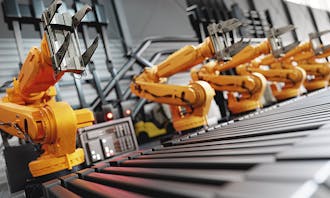How to integrate artificial intelligence into supply chains
2023-05-16
6 min read
Introducing an application of artificial intelligence into supply chains can be quite challenging. This is particularly true if this is an entirely new experience for you. We are now at the point, though, that many businesses have already delivered these kinds of projects.
Leading manufacturing, retail, and logistics companies are already making use of artificial intelligence. Ikea is using it to forecast product demand, DHL is automating repetitive operations, and Amazon uses AI to maximise its profitability. So, what can we learn from these successful projects about how can we integrate artificial intelligence into our complex supply chains?
Why should you use artificial intelligence to manage supply chains?
The latest developments in artificial intelligence technology represent fantastic opportunities to modernize and update inefficient business processes. Artificial intelligence can optimize resource allocation, predict market trends, and automate repetitive tasks. This leads to cost-cutting opportunities and unlocks new avenues for growth.
Furthermore, AI can reduce labour costs and waste, generally improving the bottom line. By integrating AI, businesses can not only achieve operational excellence but also position themselves for sustainable future success.
1. You can increase customer satisfaction
By predicting demand, artificial intelligence applications can ensure that products are available when customers need them. This means no more annoying out-of-stock situations or waiting periods.
AI can even analyse a customer’s past purchases to make product recommendations and predict buying decisions. This personalised touch adds a whole new layer to the customer experience. Instead of endless options, AI applications greet customers with suggestions tailored to their unique preferences.
After receiving a request, an AI is able to optimise the process of transportation and delivery. Customers will receive their orders in a shorter amount of time as a result of this. AI can choose the fastest, most efficient routes and keep you and your customers updated every step of the way.
The use of AI in supply chains streamlines all aspects of the purchasing process. This benefits both customers and businesses with smoother, faster, and more satisfying experiences.
2. You will reduce labour costs in the supply chain
Artificial intelligence can reduce labour costs by automating routine and repetitive tasks. As a result, workers are able to focus on complex operating tasks. AI can also optimise supply chain processes, such as routing and scheduling, reducing the need for manual interventions.
Additionally, the analytical capabilities of AI reduce the amount of guesswork involved in supply chain management. Its precise insights on routes, schedules, and inventory needs eliminate costly inefficiencies. This leads to optimised resource allocation, boosting bottom lines, and fostering sustainable growth. AI can also provide support to decision-makers by managing inventories and maintenance planning.
3. You can reduce waste with AI
Optimising inventories, asset utilisation, routing, and scheduling all work together to minimise waste in complex supply chains. Artificial intelligence applications can also tackle unnecessary waste by monitoring and addressing product quality issues in real-time. This comprehensive approach makes AI a champion for both efficiency and sustainability. As a result, there will be satisfied customers, healthy profits, and a more green planet.
Case study: Amazon’s approach to supply chain optimisation
When optimising complex supply chains, Amazon recommends an approach based on hierarchical layers. You can divide the problem into different layers. The supply chain scope, decision-making timescales, and the type of uncertainty modelling determine these layers. The complexity of the problem and the amount of effort that is necessary are then both reduced.
At the top-most hierarchical layer, the difficulty of the problem comes from its large scope. At the bottom-most layer, the complexity comes from the fine detail. The definition of each layer in the supply chain depends on its nature. However, you should roughly estimate the effort required for each layer.
Challenges faced when adopting artificial intelligence
Having an awareness of the most likely hurdles is critical to adopting any new technology. Artificial intelligence is not an exception to this rule.
1. AI Data quality and availability
Artificial intelligence applications rely on data. They need the right type of data, of the right quality, from the right places, at the right time.
Before feeding data into AI algorithms, it's crucial to ensure that we collect, process, and prepare the right data. Tasks such as data cleaning, labelling, and feature engineering are often among those included in this process. Not only will the algorithms use this data for their operations, but they will also be trained on it. Poor data quality and availability will impede any artificial intelligence project.

2. Network complexity in supply chains
Complex supply chains increase the number of things to consider when integrating artificial intelligence. The supply chain may encompass many technologies, organisations, countries, or regions. Each of these may have a different approach to regulation, data accessibility, IT infrastructure, and employee training.
3. Change management in supply chains
Adapting existing, tried-and-tested supply chain practices to include AI can have unplanned outcomes. Procedures, equipment, organisational structures, company culture, and employee roles may all experience change. To ensure that the integration process is carried out successfully, it is crucial to take a balanced approach. Understanding the importance of tradition while also embracing the potential of AI for a more efficient and adaptable future.
Approaches for successful AI integration
Integrating artificial intelligence into supply chains is a well-worn path. Organisations that have achieved positive outcomes often share the details of their projects. The major factors that support a successful conclusion are as follows:
1. Make a plan
Planning and strategizing are vital before deploying AI in your supply chain. Develop a coordinated strategy (such as Amazon’s hierarchical layering) for identifying and managing the business case for each potential solution. This ensures that technology selection aligns with strategic objectives and delivers measurable value.
2. Get visible
Obtaining end-to-end visibility of the supply chain is essential. This encompasses all aspects, including the possible areas for modernization, any existing data silos, and the expanded network. This visibility can form the basis of complete models of the supply chain.
Valuable data exists in each node of the supply chain that can improve efficiency and transparency. From raw material suppliers to manufacturers, distributors, and finally, the end customer. By breaking down data silos and gaining visibility into the entire network, you can identify bottlenecks, optimise inventory management, and predict potential disruptions.
3. Data collection for AI in supply chains
Real-time and historical data are the fuel for AI-powered decisions in your supply chain. Begin by thoroughly gathering and storing data from every step of the supply chain. Starting with locating suppliers of raw materials and ending with their delivery to clients.
By adopting this holistic approach, your AI will have access to a wide range of data. The end outcome will be more accurate forecasts and less complicated processes. In addition to a more robust supply chain that is better able to challenge market leaders.
4. Automation in the supply chain
Automation in the supply chain is crucial for realising many of the benefits of AI. The algorithms may need to make automatic adjustments to inventories, routing, and manufacturing processes. This unlocks AI's potential for a more efficient, agile, and simpler supply chain by seamlessly transforming insights into actions.
5. Collaboration in supply chains
Obtaining data and visibility of all aspects of the supply chain requires negotiation and integration. This includes interactions with any stakeholder, including consumers, suppliers, and others. Remember, a transparent and efficient supply chain benefits everyone involved.
When seeking data and collaboration, frame your requests in the context of mutual benefit. Highlighting how improved visibility and automation in supply chains can lead to shared successes across the entire network.
Embracing artificial intelligence in your supply chain is not just a technological leap. It is a strategic move towards efficiency, cost savings, and customer satisfaction. Despite the challenges, careful planning, data-driven insights, and collaboration can lead to a more agile and resilient future.
Visit our knowledge hub if you want more information on supply chain management and artificial intelligence today.



